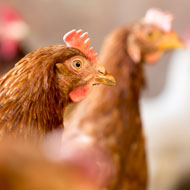Immune cell increases susceptibility to Marek’s disease

Marek’s disease virus is a major threat to the poultry industry.
A new type of immune cell that is involved in the development of Marek’s disease has been identified by scientists at The Pirbright Institute.
Writing in PLOS Pathogens, researchers from the Avian Immunology group show that Marek’s disease increases the amount of new immune cells (suppressor lymphocytes) which suppress a chicken’s immune response. They also show that higher numbers of suppressor lymphocytes increase the susceptibility of chickens to lymphoma formation.
“Some viruses exploit host immune cells for their own purpose to evade normal host defences,” said Dr Shahriar Behboudi, head of the avian immunology group at Pirbright. “We found that MDV can modulate immune responses by activating suppressor lymphocytes, contributing to immunosuppression and lymphoma formation.”
The study also reveals that lymphoma cells have similar characteristics to suppressor lymphocytes, meaning they too can suppress immune responses. Together the findings reveal new insights into the development of the disease which may help identify chicken lines that are more resistant to MDV.
Marek’s disease virus is a major threat to the poultry industry, with losses relating to the disease estimated to be up to $2 billion worldwide. The disease is highly contagious and causes lymphoma and immunosuppression in poultry.



 The Federation of Independent Veterinary practices (FIVP) has announced a third season of its podcast, Practice Matters.
The Federation of Independent Veterinary practices (FIVP) has announced a third season of its podcast, Practice Matters.